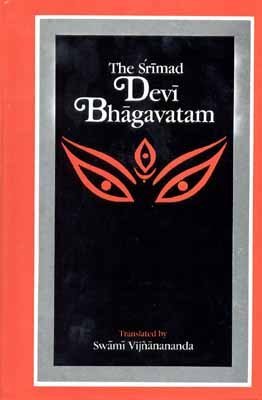The Devi Bhagavata Purana
by Swami Vijñanananda | 1921 | 545,801 words | ISBN-10: 8121505917 | ISBN-13: 9788121505918
The English translation of the Devi Bhagavata Purana. This Sanskrit work describes the Devi (Divine), the Goddess, as the foundation of the world and as identical with Brahman, the Supreme Being. The Devi Bhagavata Purana is one of the most important works in Shaktism, a branch of Hinduism focusing on the veneration of the divine feminine, along w...
Chapter 2 - On the description of the Śaktis, etc., of the syllables of Gāyatrī
1-18. Nārāyaṇa said :-- O Nārada! O Great Muni! Now hear which are the Śaktis in due order of the twenty four syllables of the Gāyatrī Devī:--
(1) Vāma Devī, (2) Priyā, (3) Satyā, (4) Viśvā, (5) Bhadravilāsinī, (6) Prabhā Vatī, (7) Jayā, (8) Śāntā, (9) Kāntā, (10) Durgā, (11) Sarasvatī, (12) Vidrumā, (13) Viśāle’sā, (14) Vyāpinī, (15) Vimalā, (16) Tamopahāriṇī, (17) Sūkṣmā, (18) Viśvayoni, (19) Jayā, (20) Vaśā, (21) Padmālayā, (22) Parāśobhā, (23) Bhadrā, and (24) Tripadā.
Now hear the respective colours of the several syllables of the Gāyatrī Devī :-- (1) like Champaka and Atasī flowers, (2) like Vidruma, (3) like crystal, (4) like lotus; (5) like the Rising Sun; (6) white like conchshell; (7) white like Kuṇḍa flower; (8) like Prabāla and lotus leaves; (9) like Padmarāga, (10) like Indranīlamaṇi; (11) like pearls; (12) like Saffron; (13) like the black collyrium of the eye; (14) red; (15) like the Vaidūrya maṇi; (16) like Ksaudra (Champaka tree, honey, water); (17) like turmeric; (18) like Kuṇḍa flower; and the milk (19) like the rays of the Sun; (20) like the tail of the bird Śuka; (21) like Śatapatra; (22) like Ketakī flower; (23) like Mallikā flower; (24) like Karavīra flower.
Now about their Tattvas :-- (1) earth; (2) water; (3) fire; (4) air; (5) Ākāśa (ether); (6) smell; (7) taste; (8) form; (9) sound; (10)
touch; (11) male generative organ; (12) anus; (13) legs, (14) hands; (15) speech; (16) Prāṇa (vital breath); (17) tongue; (18) eyes; (19) skin; (20) ears; (21) Prāṇa (up going breath); (22) Apāna; (23) Vyāna, (24) Sāmāna.
Now about the Mudrās of the syllables:-- (l) Sammukha; (2) Sampuṭa; (3) Vitata; (4) Vistṛta; (5) Dvimukha, (6) Trimukha; (7) Caturmukha; (8) Pañchamukha; (9) Ṣaṇmukha; (10) Adhomukha; (11) Vyāpakāñjali (12) Śakaṭa; (13) Yamapāśa; (14) Grathita; (15) Sanmukhon mukha (16) Vilamba; (17) Muṣṭika; (18) Matsya; (19) Kūrma; (20) Varāhaka; (21) Simhākrānta, (22) Mahākrānta; (23) Mudgara, and (24) Pallava.
The Mahāmudrās of the fourth foot of Gāyatrī are (1) Trisūlayonī (2) Surabhi; (3) Akṣa mālā; (4) Liṅga; and (5) Ambuja. O Nārada! Thus I have described to you all about the Mudras, etc., of the several syllables of the Gāyatrī. If during Japam, one thinks all these and at the same time repeats, all his sins are destroyed and his wealth gets increase and the fame attends on him.
Here ends the Second Chapter of the Twelfth Book on the description of the Śaktis, etc., of the syllables of Gāyatrī in the Mahāpurāṇam Śrī Mad Devī Bhāgavatam of 18,000 Verses by Maharṣi Veda Vyāsa.
